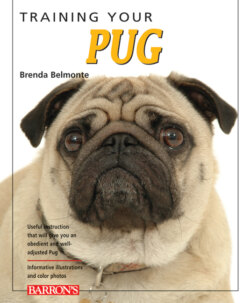Читать книгу Training Your Pug - Brenda Belmonte - Страница 16
На сайте Литреса книга снята с продажи.
Type and Temperament
ОглавлениеFor centuries. Pugs have been bred for a single purpose—to provide companionship to those who love them. The Latin phrase multum in parvo (“a lot in a little”) is used in the breed standard to describe the adult Pug. Pugs bred with this standard in mind reflect the easygoing, laid-back temperament that has long been associated with the breed.
Pugs have continued to increase in popularity on a steady basis. But as has been the trend with many other popular breeds, this rise to stardom comes with a heavy price. With demand comes an increase in poorly bred Pugs with unsound temperaments. Popular breeds often suffer when unscrupulous or uninformed individuals begin to produce puppies in large numbers, using quantity, rather than quality, as a measurement of breeding stock. “Teacup” Pugs, often bred from undersized or unhealthy parents, are now being advertised on many Web sites, though no such type of Pug exists according to the breed standard.
Over the past decade, many areas of the United States have seen a definite change in temperament related to the “type” or overall structure of Pugs. Owners who have purchased Pugs from breeders who strive to produce healthy Pugs with the smaller, square bodies, that conform to the breed standard, find that those puppies tend to grow up to be more laid-back, with a personality perfectly suited for a home companion. Thinner, leggier, “super-sized” Pugs are often more hyperactive and more independent. As adults, many of these Pugs lack the features that make the Pug unique, such as the flat, pushed in nose or dark, round eye. They are often referred to as “Victorian Pugs” or of “Victorian type.” Their owners still love them, but many will admit that their Pug’s behavior wasn’t what they expected from the breed.
Puppies should be purchased from experienced and reputable breeders.
Pugs come in only two recognized colors: fawn and black.
